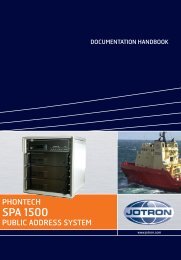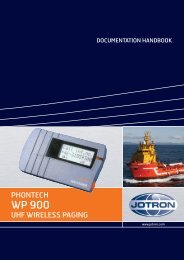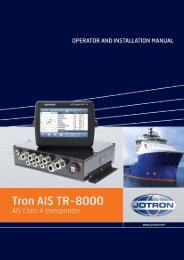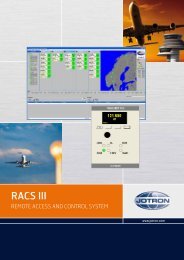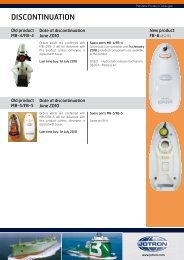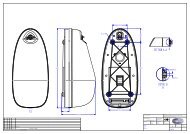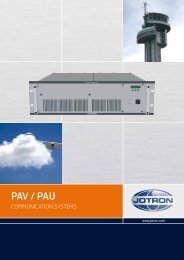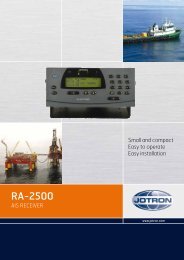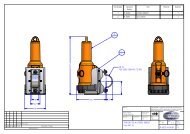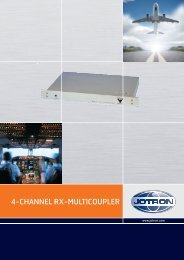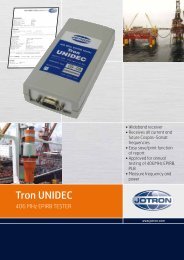Brochure TR 7750C.pdf - Jotron
Brochure TR 7750C.pdf - Jotron
Brochure TR 7750C.pdf - Jotron
Create successful ePaper yourself
Turn your PDF publications into a flip-book with our unique Google optimized e-Paper software.
• Flexible and Modular design<br />
• Utilizing the latest technology<br />
• Up to 50W RF output power<br />
• Remote or local control and<br />
operation<br />
Coastal radio<br />
The VHF Coastal radio is for coast stations and offshore installations<br />
requiring high quality FM voice and digital selective<br />
calling (DSC) requiring FM voice and digital selective calling<br />
(DSC). The radio is intended for use primarily as a coast<br />
station providing communication between coast and ships.<br />
<strong>Jotron</strong> radios have a worldwide reputation for outstanding<br />
performance in harsh environmental conditions. The mechanical<br />
design of the transceiver is based on the well proven<br />
<strong>Jotron</strong> 7000 series.<br />
FEATURES<br />
Complete solution using LAN only<br />
The coastal radios are equipped with an industry–standard<br />
set of protocols communicating through a Local Area<br />
Network. This feature may be used extensively, and the radios<br />
are designed with a LAN-only option in mind.<br />
VoIP<br />
The radios stream audio according to the EuroCAE ED137<br />
standard for Voice over IP (VoIP). This transfers voice data<br />
to/from the radios using the network connection only, hence<br />
the traditional E&M interface may remain disconnected in this<br />
case. At the same time, the network may be used concurrently<br />
for radio parameter setup and surveillance<br />
SNMP<br />
An implementation of the Simple Network Management Protocol<br />
(SNMP) is running inside the radio. Each radio works as<br />
an independent SNMP-agent, and may be managed by either<br />
a freely available MIB-browser or by <strong>Jotron</strong>s Remote Access<br />
Control System. Due to the fact that SNMP is a standard protocol,<br />
customer specific implementations<br />
are made easy. The MIB file will be made<br />
accessible upon request.<br />
Complete BITE System<br />
Built In Test Equipment (BITE) will monitor<br />
the internal status of the radio continuously.<br />
If a parameter is outside its legal<br />
range, an alarm condition will be reported<br />
in several ways. LED’s and dedicated<br />
hardware lines are set to reflect the error<br />
condition, in addition to generating SNMP<br />
traps for alarm reports to the remote system.<br />
ADDITIONAL FEATURES<br />
Audio Line Interface<br />
The coastal radio is designed with an analogue<br />
interface for the voice communication<br />
by using 4 wire E&M within the frequency<br />
range of 300-3400 Hz.<br />
Inband squelch and Keying<br />
At radio sites where the number of interfacing<br />
lines are limited, inband features<br />
will make installations easier. The inband<br />
filters are sharp, narrow notch filters generated<br />
dynamically according to the parameters set. The<br />
transmitter has programmable inband frequency and detection<br />
level for keying. No residual inband tones will be present<br />
in the final RF signal. The receiver has programmable output<br />
frequency and output level for squelch operation. By using<br />
this option the audio line interface might be limited to 4 wires<br />
only.<br />
Built-in DSC modem<br />
The coastal radio has a built-in modem for Digital Selective<br />
Calling (DSC) operation. This modem interfaces to remote<br />
system on TCP/IP. Upon receipt of a valid DSC frame on the<br />
TCP/IP interface, the radio will generate the DSC message on<br />
air according to DSC specification. If network operation is not<br />
desired, the traditional E&M interface may be used to deliver<br />
already modulated DSC messages on the audio lines.<br />
Remote operation using RS232 or RS485<br />
The radios may be controlled using RS232 and/or RS485<br />
as well. The same functionality as given through the SNMP<br />
protocol is available. Protocol document is available upon<br />
request.<br />
On-site operation<br />
The radios may be fully controlled on-site using the display,<br />
buttons and encoder. BITE measurements may be read out<br />
as well. Supervisors may restrict the access-levels of the radio<br />
to prevent unintentional setting of parameters.<br />
but needs an additional power supply, which weights 1.3 kg. All<br />
in all a complete transceiver consists of 3 units (transmitter,<br />
receiver and power supply) and the total weight is only 6.0<br />
kg. The modular and compact design makes the radio the<br />
perfect choice for distant sites that are hard to reach.<br />
Continuous duty cycle<br />
The transmitter is designed for continuous duty cycle. This<br />
makes the radio the perfect choice for messaging systems<br />
that requires high duty cycle. The unique cooling concept<br />
used on the transmitter keeps the temperature low and the<br />
operational lifetime of the equipment high.<br />
BITE system that detects failures<br />
The BITE system continuously monitors vital parts of the<br />
radio units. An error is instantly detected and reported<br />
in multiple ways. The unique main/standby concept of the<br />
<strong>Jotron</strong> 7000 series can automatically switch the operation<br />
to a standby set upon an error, providing seamless communication<br />
for the user.<br />
Keying options<br />
Keying options available in the transmitter, includes positive<br />
and negative voltages (up to 50V), keying to ground and<br />
phantom keying on the audio line. In addition the key options<br />
includes in-band tone signalling (both ways: ptt and squelch)<br />
with configurable tones and levels for easy integration with<br />
the VCS system.



